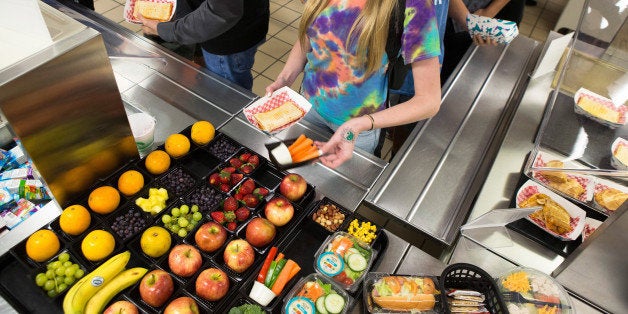
Across our nation, students are settling into back-to-school routines. Between their daily lessons in math, science and reading, there's another subject important to their academic success but often overlooked and not found on their report cards: nutrition.
Yes, it's time to talk about lunch.
Each day more than 30 million American students get their midday meals at school. For much of the last three decades, as the nation's childhood obesity rate surged, school meals weren't as healthy as they could have been. But thanks to updated school nutrition standards issued by the U.S. Department of Agriculture in 2012 -- and the work of innovative nutrition professionals -- cafeteria menus are now healthier than ever.
Today, every school lunch includes a serving of fruit or vegetables plus lean protein and foods rich in whole grains. Nearly one-third of schools have self-serve salad bars. And the stronger national nutrition standards have reduced geographic and demographic differences: Before the standards were updated, teenagers at larger schools or campuses with predominantly white enrollments were more likely to have healthy options on daily menus than students at smaller or more racially and ethnically diverse schools. But now, the smaller and more diverse schools have increased their offerings of nutritious items enough to close the gap.
Studies from Connecticut to Texas confirm what many school nutrition professionals are seeing in their lunchrooms. Under the healthier meal standards, more children are choosing and eating fruit and consuming more of their entrees and vegetables, increasing their nutrient intake and decreasing food waste. Parents and students alike support the healthier meals.
But like any classroom, successful nutrition programs and education require the right tools and professional training. Both are in too short supply. As Congress works on a five-year reauthorization of the Child Nutrition Act this fall, members should make greater support for training and new equipment a top priority.
When the updated meal standards took effect in 2012, The Pew Charitable Trusts and the Robert Wood Johnson Foundation surveyed school meal program administrators nationwide and found that 88 percent of districts reported needing at least one new piece of kitchen equipment to serve healthier meals, such as ovens to cook baked potatoes and large-capacity slicers to cut fruit and vegetables. Almost two-thirds reported staff training needs, but only 37 percent said they had the necessary funding to provide the training.
The bipartisan School Food Modernization Act, pending in both chambers of Congress, would address these obstacles to healthy, efficient meal programs. The legislation would help schools obtain loans and grants to finance kitchen updates and training for food service professionals. For a while, Congress has appropriated about $50 million in recent years to help schools purchase new kitchen equipment, availability of these resources has been irregular and limited to a fraction of the almost 100,000 schools in the United States. The modernization bill would bring improved access and predictability for schools seeking assistance with equipment upgrades and staff training.
The difference made by these investments is tangible. Anna Fisher, director of food and nutrition services for the Mount Diablo Unified School District, about 30 miles east of San Francisco, recently made use of a federal grant to help purchase a new serving line that allows students to choose their own food from a display. "We've seen that when the children select their own food, less food gets thrown away," Fisher reports. The grant also helped her district procure a walk-in refrigerator that lets the staff store and serve twice as much fresh produce while reducing energy costs.
It's clear why large majorities of voters who have children in public schools, as well as adults nationwide, want to maintain the policies spurring this progress. According to the Centers for Disease Control and Prevention, healthy kids learn better. As Congress continues to evaluate the successes and challenges of the Child Nutrition Act, the debate should not be over whether to require that school meals include healthy food. Instead, lawmakers should look at how far schools have come and build on the programs that are working so well.